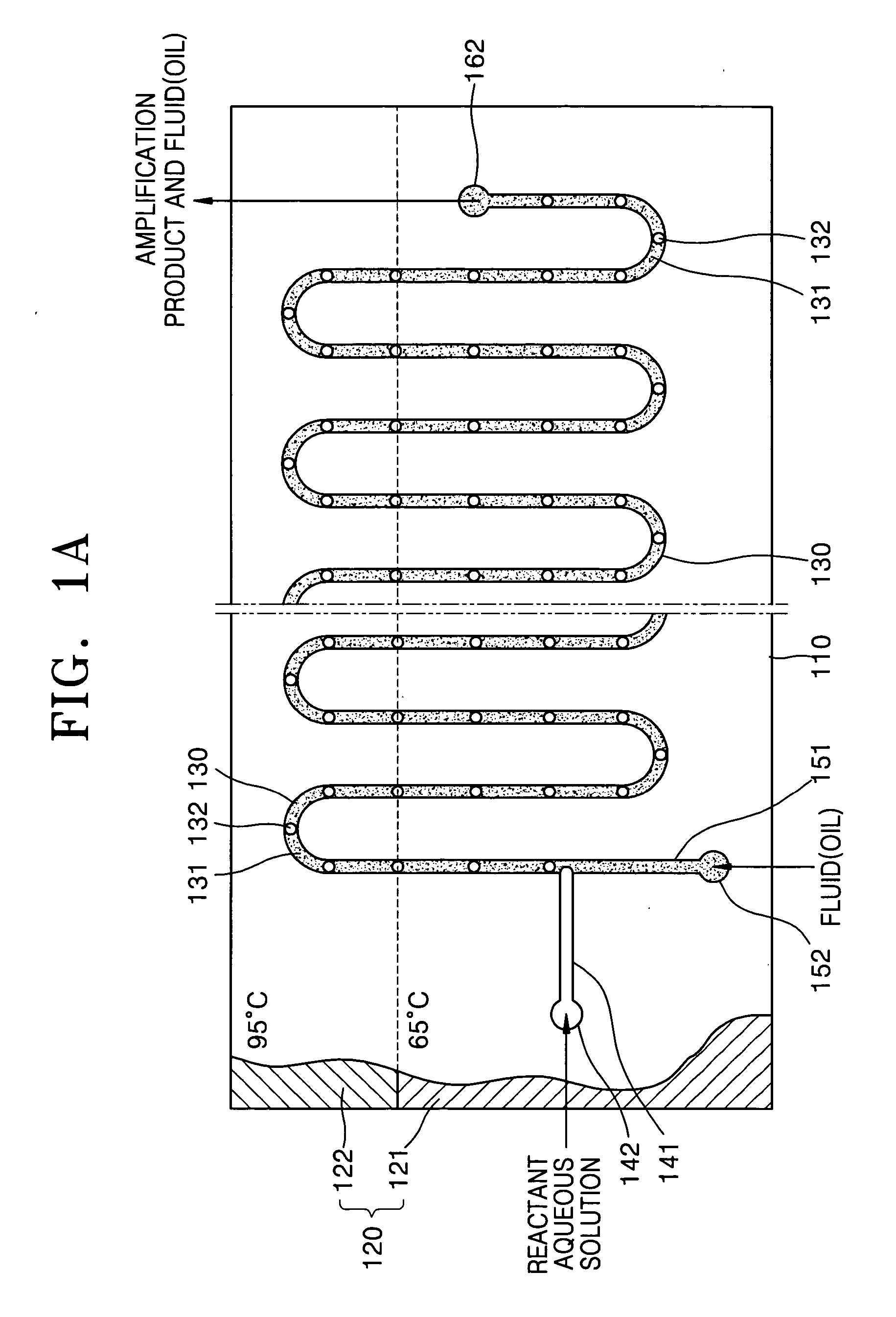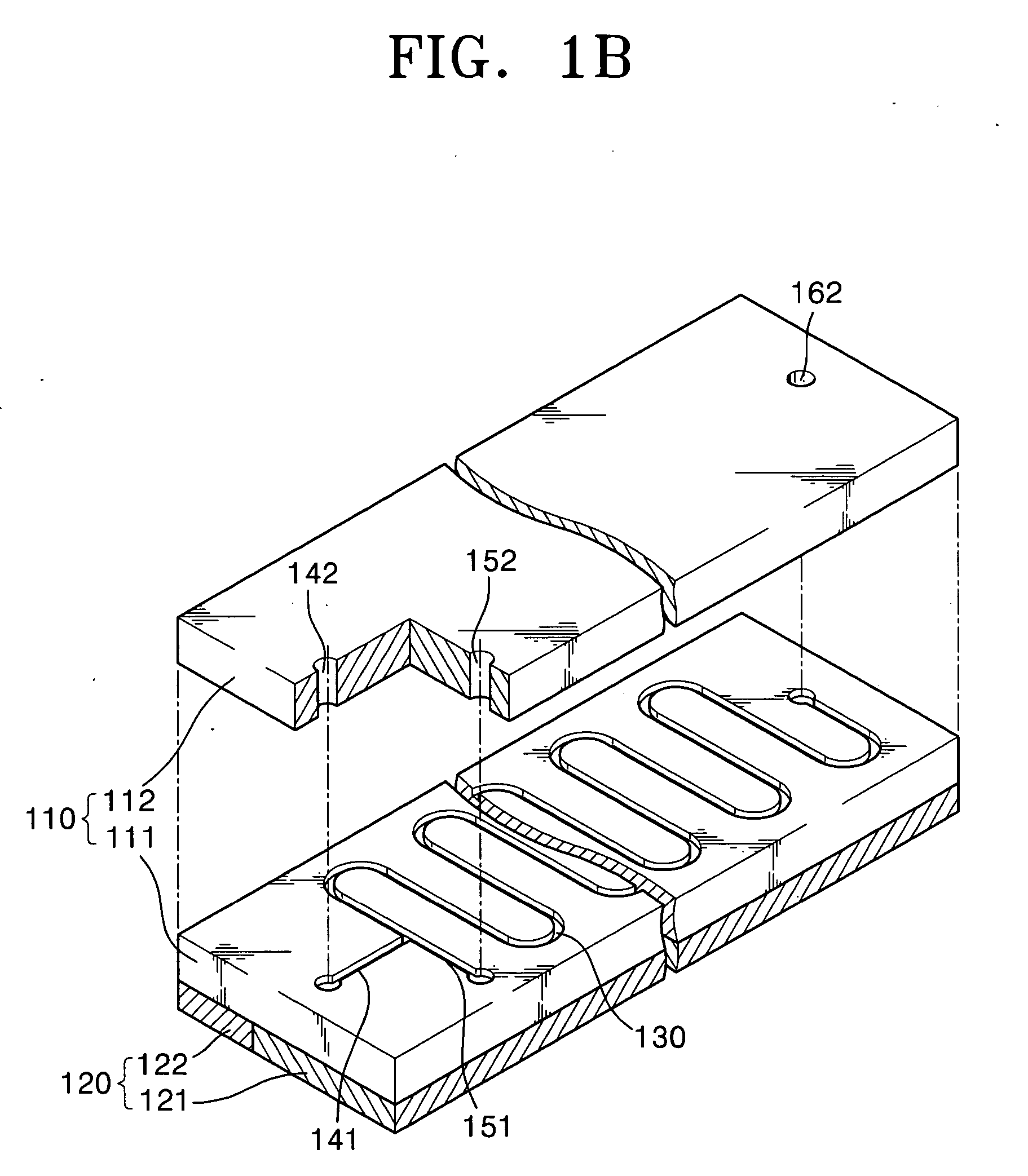Method and apparatus for amplifying nucleic acids
a nucleic acid and amplifying technology, applied in the field of methods and apparatus for amplifying nucleic acids, can solve the problems of affecting pcr amplification, requiring special attention to nested pcr techniques, and hardly performing amplification or producing non-specific pcr products
- Summary
- Abstract
- Description
- Claims
- Application Information
AI Technical Summary
Benefits of technology
Problems solved by technology
Method used
Image
Examples
first embodiment
Continuous-Flow PCR
[0066]FIG. 1A is a schematic plan view of a nucleic acid amplification apparatus according to a first embodiment of the present invention and FIG. 1B is an exploded perspective view of the nucleic acid amplification apparatus of FIG. 1A.
[0067] Referring to FIGS. 1A and 1B, the nucleic acid amplification apparatus according to the first embodiment of the present invention includes a substrate 110, a reaction channel 130 formed inside the substrate 110, at least two inlet channels 141 and 151, and a heating unit 120 for heating the substrate 110 to a predetermined temperature.
[0068] The substrate 110 may be made of PDMS (Poly Dimethyl Siloxane), silicon, silicon dioxide, plastic, or glass. Preferably, the substrate 110 has a hydrophobic surface property. When the substrate 110 is made of a material having no hydrophobic surface property, it is preferable to modify the surface of the substrate 110 so that the substrate 110 has a hydrophobic surface property. The s...
second embodiment
Real-Time PCR
[0083]FIG. 2 is a schematic plant view of a nucleic acid amplification apparatus according to a second embodiment of the present invention. FIGS. 3 and 4 are respectively a charged coupled device (CCD) image of a fluorescent signal emitted from each aqueous solution droplet and an intensity of fluorescent signal versus the number of cycles, when PCR is performed using the nucleic acid amplification apparatus according to the second embodiment of the present invention.
[0084] First, referring to FIG. 2, the nucleic acid amplification apparatus according to the second embodiment of the present invention includes a substrate 110, a reaction channel formed inside the substrate 110, a plurality of inlet channels 241, 243, 245a, 245b, 247, 249, and 151, and a heating unit 120 for heating the substrate 110 to a predetermined temperature.
[0085] Here, the constructions of the substrate 110, the reaction channel 130, and the heating unit 120 are the same as in the first embodim...
third embodiment
Multiplex PCR
[0092]FIG. 5 is a schematic plan view of a nucleic acid amplification apparatus according to a third embodiment of the present invention.
[0093] Referring to FIG. 5, in the nucleic acid amplification apparatus according to the third embodiment of the present invention, the constructions of a substrate 110, a reaction channel 130, and a heating unit 120 are the same as in the first embodiment, and thus, detailed descriptions thereof will be omitted.
[0094] The nucleic acid amplification apparatus according to the third embodiment of the present invention has a construction suitable for multiplex PCR for simultaneous analysis of multiple genes in a single apparatus. For this, the substrate 110 is formed with a plurality of, for example, three first inlet channels 341 for introduction of reactant aqueous solutions, a plurality of primer inlet channels 343 for introduction of three different primers A, B, and C into the first inlet channels 341, and a single second inlet c...
PUM
| Property | Measurement | Unit |
|---|---|---|
| temperature | aaaaa | aaaaa |
| volume | aaaaa | aaaaa |
| temperature | aaaaa | aaaaa |
Abstract
Description
Claims
Application Information
 Login to View More
Login to View More - R&D
- Intellectual Property
- Life Sciences
- Materials
- Tech Scout
- Unparalleled Data Quality
- Higher Quality Content
- 60% Fewer Hallucinations
Browse by: Latest US Patents, China's latest patents, Technical Efficacy Thesaurus, Application Domain, Technology Topic, Popular Technical Reports.
© 2025 PatSnap. All rights reserved.Legal|Privacy policy|Modern Slavery Act Transparency Statement|Sitemap|About US| Contact US: help@patsnap.com



